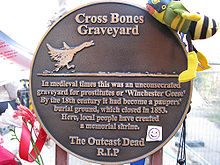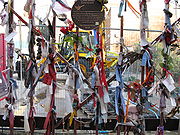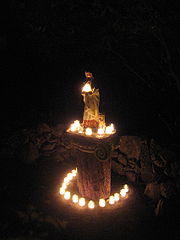
Cross Bones
Encyclopedia

Cemetery
A cemetery is a place in which dead bodies and cremated remains are buried. The term "cemetery" implies that the land is specifically designated as a burying ground. Cemeteries in the Western world are where the final ceremonies of death are observed...
in The Borough, Southwark
Southwark
Southwark is a district of south London, England, and the administrative headquarters of the London Borough of Southwark. Situated east of Charing Cross, it forms one of the oldest parts of London and fronts the River Thames to the north...
, south London
South London
South London is the southern part of London, England, United Kingdom.According to the 2011 official Boundary Commission for England definition, South London includes the London boroughs of Bexley, Bromley, Croydon, Greenwich, Kingston, Lambeth, Lewisham, Merton, Southwark, Sutton and...
, in what is now known as Redcross Way.
It is believed to have been established originally as an unconsecrated
Consecration
Consecration is the solemn dedication to a special purpose or service, usually religious. The word "consecration" literally means "to associate with the sacred". Persons, places, or things can be consecrated, and the term is used in various ways by different groups...
graveyard for "single women," a euphemism for prostitutes, known locally as "Winchester Geese," because they were licensed by the Bishop of Winchester
Bishop of Winchester
The Bishop of Winchester is the head of the Church of England diocese of Winchester, with his cathedra at Winchester Cathedral in Hampshire.The bishop is one of five Church of England bishops to be among the Lords Spiritual regardless of their length of service. His diocese is one of the oldest and...
to work within the Liberty of the Clink
Liberty of the Clink
The Liberty of the Clink was an area in Southwark, on the south bank of the River Thames, opposite the City of London. Although situated in Surrey the liberty was exempt from the jurisdiction of the county's high sheriff and was under the jurisdiction of the Bishop of Winchester who was usually...
. The liberty lay outside the jurisdiction of the City of London
City of London
The City of London is a small area within Greater London, England. It is the historic core of London around which the modern conurbation grew and has held city status since time immemorial. The City’s boundaries have remained almost unchanged since the Middle Ages, and it is now only a tiny part of...
, and as a consequence it became known for its brothel
Brothel
Brothels are business establishments where patrons can engage in sexual activities with prostitutes. Brothels are known under a variety of names, including bordello, cathouse, knocking shop, whorehouse, strumpet house, sporting house, house of ill repute, house of prostitution, and bawdy house...
s and theatres, as well as bull and bear baiting, activities not permitted within the City itself.
The age of the graveyard is unknown. John Stow
John Stow
John Stow was an English historian and antiquarian.-Early life:The son of Thomas Stow, a tallow-chandler, he was born about 1525 in London, in the parish of St Michael, Cornhill. His father's whole rent for his house and garden was only 6s. 6d. a year, and Stow in his youth fetched milk every...
(1525–1605) wrote of it in A Survey of London in 1598 calling it the "Single Woman's churchyard." By 1769, it had become a pauper's cemetery servicing the poor of St. Saviour's parish. Up to 15,000 people are believed to have been buried there.
Origins and closure



Borough High Street
Borough High Street is a main street in Southwark, London running south-west from London Bridge, forming part of the A3 road, which runs from London to Portsmouth.- Overview :...
and to the west by Redcross Way. Union Street is to the south, with Southwark Street to the north. The earliest known reference to it is from historian and antiquarian John Stow
John Stow
John Stow was an English historian and antiquarian.-Early life:The son of Thomas Stow, a tallow-chandler, he was born about 1525 in London, in the parish of St Michael, Cornhill. His father's whole rent for his house and garden was only 6s. 6d. a year, and Stow in his youth fetched milk every...
's Survey of London in 1598:
It was closed in 1853 because it was "completely overcharged with dead,' and further burials were deemed "inconsistent with a due regard for the public health and public decency." Southwark poet and playwright John Constable writes that, in 1883, the land was sold as a building site, prompting an objection from Lord Brabazon
Earl of Meath
Earl of Meath is a title in the Peerage of Ireland created in 1627 and held by the head of the Brabazon family. This family descends from Sir Edward Brabazon, who represented County Wicklow in the Irish House of Commons and served as High Sheriff of Staffordshire in 1606. In 1616 he was raised to...
in a letter to The Times, asking that the land be saved from "such desecration." Constable writes that the sale was declared null and void the following year under the Disused Burial Grounds Act 1884, and that subsequent attempts to develop the site were opposed by local people, as was its brief use as a fairground.
Excavation
Excavations were conducted on the land by the Museum of London Archaeology ServiceMuseum of London Archaeology Service
Museum of London Archaeology is a Registered Archaeological Organisation with the Institute of Field Archaeologists and is a self-financing part of the Museum of London Group, providing a wide range of professional archaeological services to clients in London, SE England, the UK and...
between 1991 and 1998 in connection with the construction of London Underground
London Underground
The London Underground is a rapid transit system serving a large part of Greater London and some parts of Buckinghamshire, Hertfordshire and Essex in England...
's Jubilee Line
Jubilee Line
The Jubilee line is a line on the London Underground , in the United Kingdom. It was built in two major sections—initially to Charing Cross, in central London, and later extended, in 1999, to Stratford, in east London. The later stations are larger and have special safety features, both aspects...
. Southwark Council reports that the archeologists found a highly overcrowded graveyard with bodies piled on top of one another. Tests showed those buried had suffered from smallpox
Smallpox
Smallpox was an infectious disease unique to humans, caused by either of two virus variants, Variola major and Variola minor. The disease is also known by the Latin names Variola or Variola vera, which is a derivative of the Latin varius, meaning "spotted", or varus, meaning "pimple"...
, tuberculosis
Tuberculosis
Tuberculosis, MTB, or TB is a common, and in many cases lethal, infectious disease caused by various strains of mycobacteria, usually Mycobacterium tuberculosis. Tuberculosis usually attacks the lungs but can also affect other parts of the body...
, Paget's disease
Paget's disease
Sir James Paget, a surgeon and pathologist, described several diseases, including:* Paget's disease of bone * Paget's disease of the breast* Paget-Schroetter disease* Extramammary Paget's disease...
, osteoarthritis
Osteoarthritis
Osteoarthritis also known as degenerative arthritis or degenerative joint disease, is a group of mechanical abnormalities involving degradation of joints, including articular cartilage and subchondral bone. Symptoms may include joint pain, tenderness, stiffness, locking, and sometimes an effusion...
, and vitamin D deficiency. A dig in 1992 uncovered 148 graves, dating from between 1800 and 1853. Over one third of the bodies were perinatal (between 22 weeks gestation
Gestation
Gestation is the carrying of an embryo or fetus inside a female viviparous animal. Mammals during pregnancy can have one or more gestations at the same time ....
and seven days after birth). A further 11 percent were under one year old. The adults were mostly women aged 36 years and older.
The Southwark Mysteries
Beginning in 1996, local writer John Constable revived the story of Cross Bones. The Southwark Mysteries is a cycle of poems and mystery plays inspired, he writes, by the spirit of a "Winchester Goose" (prostitutes licensed by the Bishop of Winchester) and "the outcast dead". The work has been performed in Shakespeare's GlobeShakespeare's Globe
Shakespeare's Globe is a reconstruction of the Globe Theatre, an Elizabethan playhouse in the London Borough of Southwark, located on the south bank of the River Thames, but destroyed by fire in 1613, rebuilt 1614 then demolished in 1644. The modern reconstruction is an academic best guess, based...
and in Southwark Cathedral
Southwark Cathedral
Southwark Cathedral or The Cathedral and Collegiate Church of St Saviour and St Mary Overie, Southwark, London, lies on the south bank of the River Thames close to London Bridge....
. Interest generated by The Southwark Mysteries inspired the Cross Bones Halloween
Halloween
Hallowe'en , also known as Halloween or All Hallows' Eve, is a yearly holiday observed around the world on October 31, the night before All Saints' Day...
festival, celebrated every year since 1998 with a procession, candles and songs.
The graveyard is now established as a site of local importance: Southwark Council nominated it for a blue plaque
Blue plaque
A blue plaque is a permanent sign installed in a public place to commemorate a link between that location and a famous person or event, serving as a historical marker....
in 2005. An informal local group, Friends of Cross Bones, is campaigning for a permanent memorial garden, and is instrumental in the halloween events. The gates in Redcross Way are permanently decorated by a changing array of messages, ribbons, flowers and other tokens.
External links
- Video montage and commentary, BBC News, 31 October 2010
Further reading
- Cross Bones Graveyard website
- Brickley, Megan; Miles, Adrian; and Stainer, Hilary. The Cross Bones Burial Ground, Redcross Way, Southwark, London. Museum of London Archeology Service, 1999.
- Constable, John. The Southwark Mysteries. Oberon Books, 1999.
- Ogden, A.R., Pinhasi, R. and White, W.J., "Gross enamel hypoplasia in molars from sub-adults in a 16th-18th century London graveyard," American Journal of Physical Anthropology, 2007.
- Tucker F. "Kill or Cure? The osteological evidence of the mercury treatment of syphilis in 17th to 19th-century London," London Archaeologist, Volume 11, Number 8, 2007, pp. 220-224.
- Google Maps - Cross Bones Graveyard
- Goose and Crow
- Southwark Mysteries website
- Cross Bones Graveyard at FLICKR
- Waking the Dead: the Crossbones Graveyard
- Campaigning to protect an ancient graveyard
- Crossbones Girl, BBC2 History Cold Case
- BBC News audio slideshow: Crossbones

